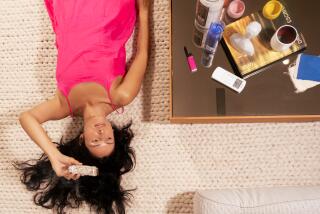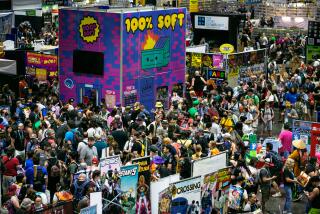Tressed for Success
- Share via
The International Salon and Spa Expo at the Los Angeles Convention Center was an MTV-style affair, with pulsing music, outrageous fashions and more hair color than nature ever intended. The vast majority of the 35,000-plus attendees, mostly salon professionals, were women. Several of the men roaming the seemingly endless aisles of nail polish, brushes, mousse, gel and moisturizer were wearing skirts.
More than 200 vendors, including big names such as Wella International, Conair and John Paul Mitchell Systems, vied for the crowd’s attention. Their objective? Getting their products into salons.
For the record:
12:00 a.m. Feb. 16, 2001 For the Record
Los Angeles Times Friday February 16, 2001 Home Edition Southern California Living Part E Page 3 View Desk 1 inches; 20 words Type of Material: Correction
Misspelled byline--In Thursday’s story about the International Salon and Spa Expo, the first name of reporter Leslee Komaiko was misspelled.
Purveyors used a variety of methods to turn heads and keep them that way, including elaborate booths, giveaways, compelling sales pitches and informal classes in makeup application and hairstyling. By far the most popular marketing tool was basic sex appeal.
“It’s all about image and having fun and looking good,” said Scott Emery, national sales manager for Farouk Systems, a maker of all-natural hair-care products. Farouk had hired a pair of chiseled male go-go dancers, dressed them in matching white ribbed tanks and black leather pants, and set them loose on a stage. Soon, their provocative gyrations drew a throng of giddy women who hooted in approval, especially when the men ripped off their shirts and tossed them to the crowd. “This industry is 75% women,” said Emery. “We use a lot of male models.”
*
Meredith Bowles, 17, a hair student at Dallas Roberts Academy in Utah, nabbed one of the shirts. For Bowles, who was in town with her friend and fellow student Ashley Stewart, this was the hands-down highlight of the weekend. But, she added, “I’ve learned so much about product and color.”
Not everyone was having quite as much fun.
“It’s exhausting,” said Cesar Lopez, president of Chenice, a Beverly Hills company that manufactures makeup and hair-care products.
“It’s a lot of work,” concurred Hien Tran, a hairstylist at the White Orchid salon in Santa Ana who was plying his trade for Ariella, maker of various hairstyling products. During the three-day show, which ended Monday, he created dozens of offbeat hairstyles for women. It was a nice change from the salon, he said, where “they come in and all want the same thing.” The show was “a chance to play,” he said, as he fashioned Pippi Longstocking-like pigtails on a model. “You do this for high school girls, college girls. You cannot do this for the president of a company.”
Everywhere there was hair, there was knotted hair. On the main floor, Herman Colt, a stylist at the Alberto Borrelli salon in West Hollywood, was teaching several styles using knots for John Paul Mitchell Systems. “A lot of the looks in our collection stem from runways in New York,” he said. “Knots are very popular right now.” Besides, he added, “it looks more artistic than the old ponytail.”
As Colt knotted, a different lesson was taking place upstairs. Joe Platia Jr., a Pennsylvania makeup artist and stylist, was sharing his “human canvas” techniques with about two dozen curious aestheticians looking to broaden their skills. On a small stage, he taped, airbrushed, stenciled and painted a model’s legs and arms using nontoxic, water-based acrylics as the model stood motionless, wrapped in a white towel. While he worked, the audience fired off questions, including one referring to a famous Vanity Fair cover photograph: “How do you think they did Demi Moore?” “To me,” said Platia, “it looked like greasepaint. Greasepaint is a nightmare. It is so difficult to work with.”
*
Though the audience was compelled by Platia’s fantastical work--he replicated in paint highly detailed thigh-high stockings and long gloves--one important question remained: “Is there money in it?”
It was the question on everyone’s mind at the expo, not just in Platia’s makeshift classroom. “Absolutely,” he answered.
After all, the U.S. salon industry brings in about $45 billion a year for products and services.
Art for art’s sake this wasn’t.






